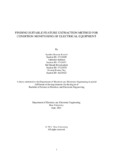| dc.contributor.advisor | Huda, A. S. Nazmul | |
| dc.contributor.advisor | Mohsin, Abu S.M. | |
| dc.contributor.author | Karobi, Synthia Hossain | |
| dc.contributor.author | Rahman, Tahmidur | |
| dc.contributor.author | Khoshnabish, Md Shoaib | |
| dc.contributor.author | Dey, Swarup Kumar | |
| dc.date.accessioned | 2021-09-30T13:03:50Z | |
| dc.date.available | 2021-09-30T13:03:50Z | |
| dc.date.copyright | 2021 | |
| dc.date.issued | 2021-06 | |
| dc.identifier.other | ID 17121049 | |
| dc.identifier.other | ID 17121071 | |
| dc.identifier.other | ID 17121078 | |
| dc.identifier.other | ID 16221022 | |
| dc.identifier.uri | http://hdl.handle.net/10361/15086 | |
| dc.description | This thesis is submitted in partial fulfillment of the requirements for the degree of Bachelor of Science in Electrical and Electronic Engineering, 2021 | en_US |
| dc.description | Cataloged from PDF version of thesis. | |
| dc.description | Includes bibliographical references (pages 139-140). | |
| dc.description.abstract | The degradation of electrical equipment caused by excessive temperature rise leading to the failure of a total electrical system can be reduced by the thermal monitoring of the equipment.
Manual analysis of thermal images is time-consuming, cost-effective and can cause injuries or health damages. Therefore, building an automated fault diagnosis system plus selecting the suitable features for developing that system is essential. As there are several feature extraction methods and applying all of them to identify suitable features is time-consuming and creates
extra loads on the automated system, choosing one efficient method for feature extraction is
necessary. This study actually shows the comparison among different texture feature extraction
techniques and find the best one by using Machine Learning. After extracting different features
using different methods from thermal images of electrical equipment, firstly, supervised
learning was used along with Random Forest as a classifier and then training-testing data were
used to train the machine and predict the segmented regions of the pictures. The study result
shows that using Gray-Level Co-Occurrence Matrix as feature extracting method gave the most
accuracy and less error in the performance analysis algorithm. Finally, the condition of the
electrical equipment is also predicted whether it was faulty or normal in addition to which
feature extracting method provides most accuracy. | en_US |
| dc.description.statementofresponsibility | Synthia Hossain Karobi | |
| dc.description.statementofresponsibility | Tahmidur Rahman | |
| dc.description.statementofresponsibility | Shoaib Khoshnabish | |
| dc.description.statementofresponsibility | Swarup Kumar Dey | |
| dc.format.extent | 140 pages | |
| dc.language.iso | en | en_US |
| dc.publisher | Brac University | en_US |
| dc.rights | Brac University theses are protected by copyright. They may be viewed from this source for any purpose, but reproduction or distribution in any format is prohibited without written permission. | |
| dc.subject | Infrared Thermography | en_US |
| dc.subject | Texture Analysis | en_US |
| dc.subject | Co-occurrence Matrix | en_US |
| dc.subject | Condition Monitoring | en_US |
| dc.subject | Region of Interest | en_US |
| dc.subject | Feature Extraction | en_US |
| dc.subject | Auto Regression | en_US |
| dc.subject | Moment Binary | en_US |
| dc.subject | Gradient | en_US |
| dc.subject | Level Run-length Matrix | en_US |
| dc.subject.lcsh | Electronic apparatus and appliances | |
| dc.title | Finding suitable feature extraction method for condition monitoring of electrical equipment | en_US |
| dc.type | Thesis | en_US |
| dc.contributor.department | Department of Electrical and Electronic Engineering, Brac University | |
| dc.description.degree | B. Electrical and Electronic Engineering | |

